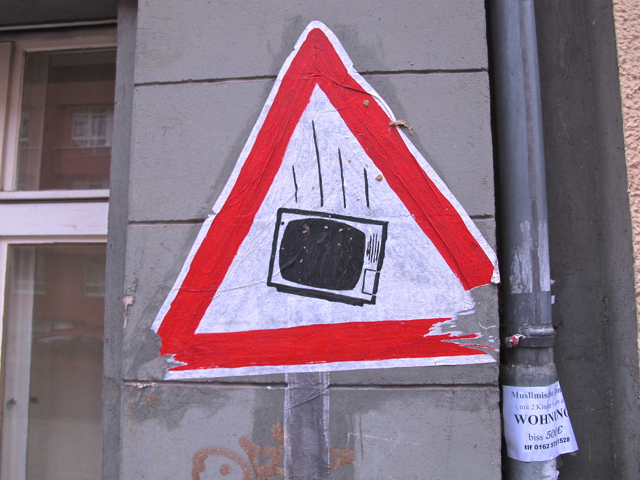A cathode ray tube was in my way. “What an appropriate start to my day,” I thought, as I pushed it aside, in order to exit the building. My first day back in Berlin, after spending a couple of weeks in Stuttgart, nothing could have better signified my return home. Someone had smashed an old TV set in front of the door overnight. I tightened my hold of my dogs’ leads. I didn’t want to them stepping on any of the broken glass, or circuit board parts, spread out on the sidewalk.
Few neighborhoods can boast of the number of discarded televisions found in Neukolln. A constant feature of the area’s sidewalks, for the three years that I’ve resided in the borough, I’d wager I run into one or two itinerant sets a week. Being a dog owner, perhaps I’m more prone to noticing such things than others. Berlin is an especially filthy city. I find myself constantly on the lookout for items that might harm my Schnauzers. Televisions, fortunately, are easily avoidable. They’re a lot bigger than broken beer bottles, for example, or, as Berliners are all too familiar with, random piles of dog shit.

For media critics, seeing so many unwanted television sets, day in an day out, has a special significance. “Ideological state appliances,” to paraphrase the late philosopher Louis Althusser, TVs are the iconographic distribution points for ideology. Whether it be the state, as the pun infers, or the market, for many a Cold War era progressive, television performed the same political function. Everything you watched was meant to influence your political prejudices. It mattered little whether it was Coronation Street, or The Brady Bunch, The X-Files, or Life on Mars. If you watched too much television, you were liable to become politically compliant, in the most Brave New World sorts of ways.

Considering the purpose of television broadcasting in the former DDR (a stereotypically ideological apparatus, à la Althusser) the revenge being taken on these television sets made sense. The Cold War might be two decades behind us. However, Germans are still in the process of exorcising the ghosts of the past, and most likely will, well into the future. Yet, I’m not so certain it’s as simple as that. Not everyone in my neighborhood is from the former East Germany. (Nearly half of the borough is estimated to be of immigrant background.) Considering the amount of home electronic stores in the neighborhood, a significant amount of its residents could simply be disposing of their CRTs in favor of LCDs. A lot of them.

There’s no real way of knowing. I prefer the ambiguity, frankly. The uncertainty makes it easier to conjecture. I can, for example, look at the photograph above, of a television’s empty case, filled with refuse, and experience the best kinds of cultural studies-tutored fantasies. It’s been filled with litter because that’s what it projected, metaphorically speaking, in real life. Conversely, I’m also free to imagine that TVs are static, meaningless objects, without any real influence or authority over peoples’ lives. Certainly, the laissez-faire manner in which they are left on Neukolln’s streets, and abused, from what it appears, by passersby, suggests as much.
Personally, I like watching TV. Though I don’t do it that often, I find that the times I do, it’s amusing, and that I’m discriminating enough to choose between the good and the bad. Still, I think, there’s something healthy about disposing of televisions this way, even if there’s nothing especially political behind it. The qualification, I think, is important. As evinced by the very first image used in this article (a faux yield sign, with a falling television set inside it) televisions have not stopped being objects of satire. This said, it’s nice to know that in Neukolln, there is no consensus on their significance. Except, that is, their shelf lives, and where they best belong, when they’re no longer considered useful.
Photographs and commentary courtesy of Joel Schalit





